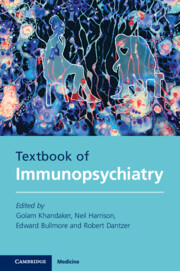Book contents
- Immunopsychiatry
- Immunopsychiatry
- Copyright page
- Contents
- Foreword
- Contributors
- Chapter 1 Basic Concepts in Immunobiology
- Chapter 2 From Psychoneuroimmunology to Immunopsychiatry: An Historical Perspective
- Chapter 3 Stress, Immune System and the Brain
- Chapter 4 The Role of Prenatal and Childhood Infection and Inflammation in Schizophrenia
- Chapter 5 The Role of Autoimmune Encephalitis in Immunopsychiatry and Lessons from Neuropsychiatric Systemic Lupus Erythematosus
- Chapter 6 Effectiveness of Immunotherapies for Psychotic Disorders
- Chapter 7 Inflammation, Sickness Behaviour and Depression
- Chapter 8 Immunotherapies for Depression
- Chapter 9 The Effect of Systemic Inflammation on Cognitive Function and Neurodegenerative Disease
- Chapter 10 Role of Inflammation in Lewy Body Dementia
- Chapter 11 The Role of Adaptive and Innate Immunity in Alzheimer’s Disease
- Chapter 12 The Immune System and Anxiety Disorders
- Chapter 13 Microbiome-Gut-Brain Interactions in Neurodevelopmental Disorders: Focus on Autism and Schizophrenia
- Chapter 14 Depression and the Adaptive Immune System
- Chapter 15 Transdiagnostic Features of the Immune System in Major Depressive Disorder, Bipolar Disorder and Schizophrenia
- Index
- Plate Section (PDF Only)
- References
Chapter 10 - Role of Inflammation in Lewy Body Dementia
Published online by Cambridge University Press: 02 September 2021
- Immunopsychiatry
- Immunopsychiatry
- Copyright page
- Contents
- Foreword
- Contributors
- Chapter 1 Basic Concepts in Immunobiology
- Chapter 2 From Psychoneuroimmunology to Immunopsychiatry: An Historical Perspective
- Chapter 3 Stress, Immune System and the Brain
- Chapter 4 The Role of Prenatal and Childhood Infection and Inflammation in Schizophrenia
- Chapter 5 The Role of Autoimmune Encephalitis in Immunopsychiatry and Lessons from Neuropsychiatric Systemic Lupus Erythematosus
- Chapter 6 Effectiveness of Immunotherapies for Psychotic Disorders
- Chapter 7 Inflammation, Sickness Behaviour and Depression
- Chapter 8 Immunotherapies for Depression
- Chapter 9 The Effect of Systemic Inflammation on Cognitive Function and Neurodegenerative Disease
- Chapter 10 Role of Inflammation in Lewy Body Dementia
- Chapter 11 The Role of Adaptive and Innate Immunity in Alzheimer’s Disease
- Chapter 12 The Immune System and Anxiety Disorders
- Chapter 13 Microbiome-Gut-Brain Interactions in Neurodevelopmental Disorders: Focus on Autism and Schizophrenia
- Chapter 14 Depression and the Adaptive Immune System
- Chapter 15 Transdiagnostic Features of the Immune System in Major Depressive Disorder, Bipolar Disorder and Schizophrenia
- Index
- Plate Section (PDF Only)
- References
Summary
Lewy body dementia (LBD) is an umbrella term used to group together the two closely related conditions of dementia with Lewy bodies (DLB) and Parkinson’s disease dementia (PDD). Cortical neuronal Lewy bodies and Lewy neurites are found in both conditions at autopsy. As well as dementia, DLB and PDD also share common clinical features including fluctuations in attention, visual hallucinations and parkinsonism (1,2). If parkinsonism is present one year before the onset of dementia, patients are diagnosed with PDD, if it is less than one year, or it is not present, the diagnosis is DLB.
- Type
- Chapter
- Information
- Textbook of Immunopsychiatry , pp. 190 - 212Publisher: Cambridge University PressPrint publication year: 2021

